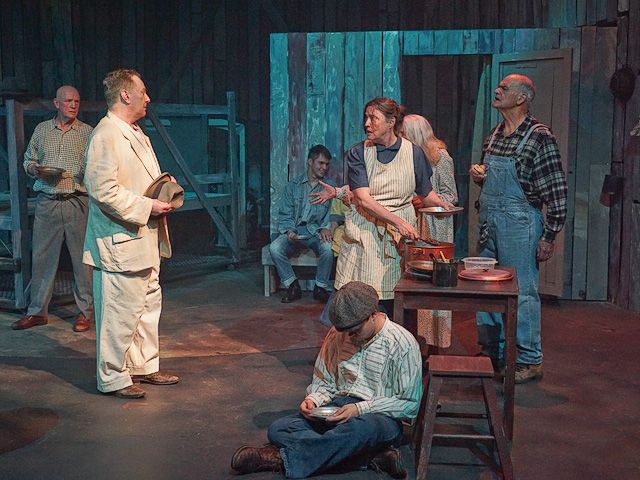Theatre 3
13-29 February 2020
The
Grapes of Wrath by
John Steinbeck (published 1939) is one of those classic great American novels –
it is taught in American high schools to the point that everybody knows it,
even if they’ve only read the cheat notes or seen the 1940 film (directed by
Tom Ford and starring Henry Fonda as Tom Joad) in
order to pass the test. And it is a test. Full disclosure: I studied it at High
School in New York (U.S.A), and I studied it for my university degree at Manchester (U.K.).
The 1988 play adapted by Frank
Galati won the Tony Award for best play in 1990, and in the last thirty years
has become a perennial favourite of high school productions. This is both a
good and a bad thing, and a context with which to inform the Canberra Repertory
production, directed by Chris Baldock.
The plot is fairly simple. During
the Great Depression, the Joad family are driven off their land in Oklahoma due
to a combination of drought, economic hardship, bank foreclosures and
agricultural industry changes. They light out for the West (it is the American
Dream, after all) in hopes of finding solid work and good fortune. It is not a
spoiler to say things don’t turn out that way.
The set (designed by Chris
Baldock; co-ordinated by Russell Brown) drew rounds of applause from the
audience. It is a good set, made from pallets and angular constructions which variously
represent houses, riverbanks and graves. The scene changes are complex and occasionally
clunky, diverting attention from the dialogue or the emotion on stage to
appreciation of the artifice.
The jalopy which the Joads load to travel to California is created on stage from flats and loaded
up with bags and wheels, although it recalls The Wiggles more than the spirit
of desperate adventure. At one point a rain curtain creates a deafening noise
over which the actors cannot be heard, and soaks the stage although, strangely,
not the actors. I refer to them as actors rather than characters,
as this is another of those ‘stepping outside of the scene for the sake of the
set’ moments.
The theme of family, friendship
and community is one of the most powerful aspects of the story, and initially
this is well handled as the multi-generational Joad family bustles about the
stage doing chores and preparing a communal meal. It is also nicely contrasted
with the isolation felt by Tom Joad (James McMahon) as he returns from a
stretch in prison and encounters Jim Casey (Michael Sparks), the ex-preacher,
who is struggling to come to terms with his new identity and the situation that
has forced them away from all they have known.
As the family and a few extras
embark on their journey this sense of community falls apart. Partly this is as
members of the clan drop off by the wayside – Noah’s defection as played by
John Whinfield is particularly affecting – but also because there is no sense
of unity between the company. This should be an ensemble piece, but various
actors proclaim and hold forth in a singular way without any perceivable warmth
for their fellow cast. James McMahon and Amy Dunham (in a welcome return to the
stage as Rose of Sharon) make overtures to the rest of the family, but they are
almost rebuffed by a fearsome Ma (Karen Vickery), whose defensiveness is
overplayed to the exclusion of the softer side of the matriarch.
Tom, Casey, and also Uncle John (played
with hyper intensity by an almost unrecognisable Jerry Hearn), undergo personal,
political and spiritual development with sensitivity and depth, dealing with
hokey hillbilly dialogue – ‘There ain’t no sin and there ain’t no virtue. There’s
just stuff people do’ – in a way that credits the acting and directing skills of all concerned. Considering this is a tale that led many to consider the
implications of social economics, the differences between the socialist site
and the capitalist camp are understated. Sure, the row of tents looks lovely, and the wire fence is an obvious allusion to
camps closer to home, but the imminent threat is absent and the discussions about self-determination, unions, the rights of the worker,
and responsibilities of the employer lack passion and are uninspiring.
Essential qualities such as honour
and resistance are given every chance to shine, and they do in solitary
monologues but are lost in group moments: the dance and fight scenes are
awkward, and the characters are not believable as the rough-and-ready types
they represent. It is a stretch to believe in the resilience and perseverance of
these average people whom circumstances have made extraordinary and it is not
always clear that “We’re the people that live. They can’t wipe us out, they can’t
lick us. We’ll go on forever, cos we’re the people.”
That’s not to say that there aren’t
emotional scenes: the choices made in the face of starvation and the compassion
shown by those suffering personal hurts are at times beautifully portrayed, not
least by Dunham in the final scene. The lights fade on a touching tableau, highlighting
human dignity; finally the motif of individual sacrifice to the greater good of
the community is clear – and that is a wonderful way to finish. Power to the
people.




